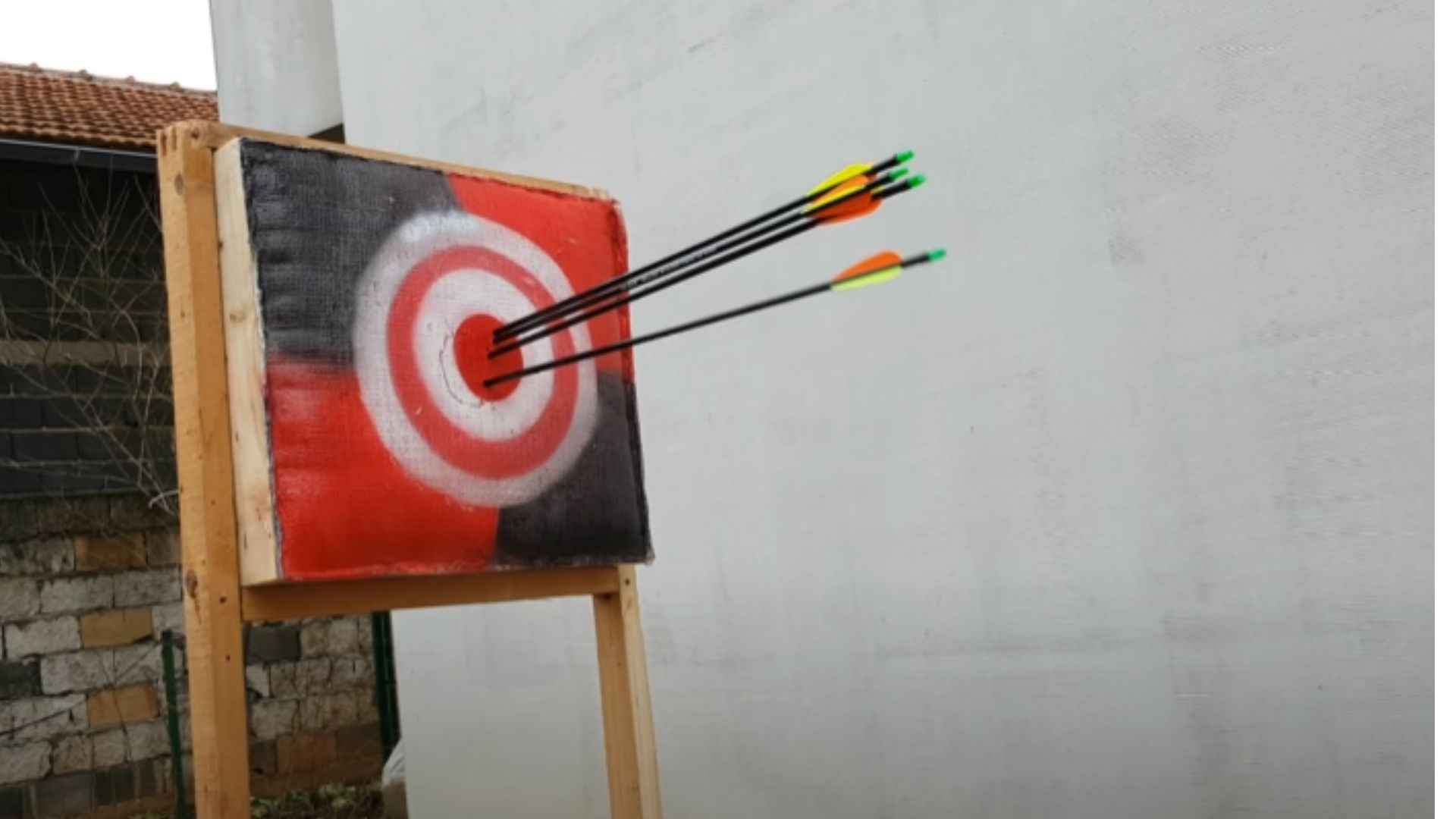Archery targets are typically made of materials such as foam, straw, or layered sheets of paper or fabric.
Layered Foam Targets
When it comes to archery practice, having the right target is crucial for honing your skills. One popular type of archery target is the layered foam target. These targets are designed to provide optimal performance and durability, making them a favorite among archers of all levels. Let’s take a closer look at the construction and composition of layered foam targets.
Construction And Composition Of Layered Foam Targets
Layered foam targets are made up of multiple high-density foam layers, each serving a specific purpose in providing a responsive and long-lasting target. The construction of these targets is meticulously designed to enhance arrow stopping capabilities, ensuring a satisfying and effective practice session.
High-density Foam Layers
The main component of layered foam targets is high-density foam layers. These layers are typically made from strong and durable polymers, such as polyethylene or polyurethane. The high-density foam not only provides a sturdy surface for arrow penetration but also ensures the target can withstand repeated shots without losing its shape or effectiveness.
Self-healing Properties
One of the key features of layered foam targets is their self-healing properties. Thanks to the composition of the foam layers, these targets have the remarkable ability to close up the entry holes created by arrows. This means that you can practice for extended periods without needing to replace or repair the target frequently, saving time and money in the long run.
Enhanced Arrow Stopping Capabilities
The layered foam composition of these targets provides enhanced arrow stopping capabilities. The different foam layers work together to slow down the arrow’s momentum and distribute the impact force evenly. This not only prevents arrow pass-through but also reduces the risk of damaging or losing arrows during practice sessions.
In conclusion, layered foam targets offer archery enthusiasts an excellent option for their practice needs. The construction and composition of these targets, consisting of high-density foam layers with self-healing properties, contribute to their enhanced arrow stopping capabilities. With layered foam targets, you can focus on improving your shooting skills without worrying about frequent replacements or damaged arrows.
Modern Archery Targets
Materials Used In Modern Archery Targets
Archery has come a long way since its early days, and so have archery targets. Modern archery targets are a result of advancements in material technology, designed to withstand the impact of arrows and provide accurate feedback to the archer. Let’s take a closer look at the materials used in these targets.
Layered Foam Sheets
Layered foam sheets are a popular choice for modern archery targets due to their ability to absorb the force of the arrow while maintaining their shape. These targets are constructed by stacking multiple layers of high-density foam sheets, typically made from ethylene-vinyl acetate (EVA) foam or polyethylene foam, and binding them together. The layers of foam serve as a cushion, preventing the arrow from penetrating too deeply and making it easier to remove them.
Self-healing Foam
Another material used in modern archery targets is self-healing foam. This foam has the remarkable ability to close up the hole left by an arrow, minimizing damage and extending the lifespan of the target. The foam molecules in self-healing targets have a high degree of elasticity, allowing them to return to their original shape after being pierced by an arrow. This makes self-healing foam targets an economical and long-lasting choice for both recreational and professional archers.
Reinforced Plastic
In addition to foam, reinforced plastic is also used in some modern archery targets. This type of target consists of a solid plastic body with specially designed recesses to catch and stop the arrow. The plastic material used is typically high-density polyethylene (HDPE) or similar robust plastics that can withstand repeated arrow impacts without cracking or breaking. Reinforced plastic targets are known for their durability and weather resistance, making them suitable for outdoor use.
Synthetic Fabrics
Lastly, synthetic fabrics are often incorporated into modern archery targets to enhance their performance. Fabrics like nylon or polyester are strategically placed on the surface of the target to provide a smooth, durable, and consistent texture. This helps to reduce friction between the target and the arrow, allowing for a more accurate and consistent shot. The synthetic fabrics also aid in preventing the arrows from penetrating too deeply, making them easier to pull out.
Overall, modern archery targets are made from a combination of materials that prioritize durability, easy arrow removal, and accuracy. Layered foam sheets, self-healing foam, reinforced plastic, and synthetic fabrics all play crucial roles in creating targets that are capable of withstanding the force of archery arrows and providing valuable feedback to archers of all skill levels.
Synthetic Fabric Targets
When it comes to archery targets, synthetic fabric targets have gained popularity due to their durability and versatility. These targets are made from a combination of synthetic materials that provide optimal functionality and a satisfying shooting experience. Let’s explore the composition and features of synthetic fabric targets.
Composition And Features Of Synthetic Fabric Targets
Synthetic fabric targets are typically composed of layered fabric sheets, designed to withstand the impact of arrows. Each layer is carefully engineered to maximize the target’s longevity and enhance its overall performance. The unique composition of these targets ensures an excellent balance between strength and flexibility.
One of the standout features of synthetic fabric targets is noise reduction and arrow containment. These targets are specially designed to minimize the sound produced when arrows hit the surface. This allows archers to focus on their shots without disturbances, creating a more immersive experience. Additionally, the fabric layers effectively contain arrows, preventing them from penetrating through and potentially causing damage or injury.
Another notable feature of synthetic fabric targets is their weather resistance and portability. These targets are designed to withstand various weather conditions, making them suitable for both indoor and outdoor shooting. Whether it’s rain or shine, you can rely on the durability of synthetic fabric targets. Furthermore, their lightweight construction allows for easy transportation, enabling archers to practice their skills in different locations.
Layered Fabric Sheets
Layered fabric sheets are an essential component of synthetic fabric targets. These sheets are typically made from durable synthetic materials, such as nylon or polyester, which provide exceptional strength and resilience. The number of layers can vary depending on the target’s intended use and desired stopping power. The multiple layers work together to distribute the force of the arrow evenly and prevent it from penetrating too deeply.
Noise Reduction And Arrow Containment
The design of synthetic fabric targets prioritizes noise reduction and arrow containment. The layered fabric sheets absorb the impact of the arrows, reducing the sound produced upon impact. This feature is especially beneficial for archers who prefer a quieter shooting experience or those practicing in residential areas where noise restrictions may apply. Moreover, the strong fabric layers effectively stop the arrows, preventing them from passing through the target. This ensures the safety of both the archer and the surrounding environment.
Weather Resistance And Portability
Synthetic fabric targets are designed to withstand various weather conditions, making them highly versatile. The fabric materials used in their construction are resistant to moisture, UV rays, and temperature changes. This ensures that the targets maintain their performance and structural integrity over time. Additionally, these targets are lightweight and easy to transport. They can be easily folded or rolled up, allowing archers to take them to different shooting locations with convenience.
Self-healing Foam Targets
Composition And Advantages Of Self-healing Foam Targets
Self-healing foam targets are an essential part of every archer’s training regimen. Made from a unique composition of advanced elastomeric foam technology, these targets offer numerous advantages that make them the ideal choice for both beginners and experienced archers alike. Elastomeric foam technology, a cutting-edge material used in the construction of self-healing foam targets, provides exceptional durability and longevity. The combination of elastomers and foam creates a strong, yet flexible material that can withstand continuous arrow impacts. Unlike traditional targets that quickly deteriorate with repeated use, self-healing foam targets bounce back, regenerating after each hit.
Elastomeric Foam Technology
The key to self-healing foam targets’ exceptional performance lies in the elastomeric foam technology. This innovative material features tiny air bubbles encapsulated within a durable elastomer matrix. These air bubbles serve as micro-cells, compressing when impacted by an arrow and then quickly regaining their original shape. This unique behavior allows the target to absorb the force of the arrow, reducing the likelihood of arrow pass-through and minimizing damage to the target.
Durability And Longevity
The durability and longevity of self-healing foam targets set them apart from other target materials. The elastomeric foam composition ensures that these targets can withstand relentless arrow impacts without significant wear and tear. This means that archers can enjoy extended target practice sessions without the need for frequent target replacements. Additionally, the exceptional durability of self-healing foam targets greatly reduces the cost and frustration associated with constantly replacing worn-out targets.
Easy Arrow Removal
One of the standout advantages of self-healing foam targets is their easy arrow removal. The elasticity of the foam allows the arrows to effortlessly penetrate the target, and upon retrieval, the foam closes back up, leaving little to no visible trace of the arrow’s entry point. This eliminates the need for excessive pulling force or arrow extraction tools, reducing the risk of arrow damage and ensuring a more convenient shooting experience. Archers can focus on honing their skills instead of struggling with arrow removal. In conclusion, self-healing foam targets offer a superior archery experience, thanks to their unique elastomeric foam technology. With outstanding durability and longevity, these targets are built to withstand the demands of continuous arrow impacts. The easy arrow removal further enhances the convenience and enjoyment of archery sessions. Whether you’re a seasoned archer or just starting, self-healing foam targets are the go-to choice for improving accuracy and precision in your shooting.
Reinforced Plastic Targets
Reinforced plastic targets are a popular choice among archers for their durability, lightweight design, and weather-resistant properties. These targets are made from a combination of high-quality plastic materials that are specifically engineered to withstand the impact of arrows and provide long-lasting performance. In this section, we will delve into the characteristics and benefits of reinforced plastic targets, including their weather-resistant properties and lightweight, portable design, ensuring you have all the information you need to make an informed decision for your archery practice.
Characteristics And Benefits Of Reinforced Plastic Targets
Reinforced plastic targets are known for their exceptional characteristics and numerous benefits. Let’s take a closer look at some of these attributes:
Weather-resistant Properties
One of the standout features of reinforced plastic targets is their ability to withstand various weather conditions. Whether it’s scorching heat, heavy rain, or freezing temperatures, these targets are designed to hold up under extreme elements. Unlike traditional targets made from materials such as straw or foam, reinforced plastic targets won’t deteriorate or become damaged when exposed to the elements. This makes them an excellent choice for outdoor archery practice, allowing you to hone your skills regardless of the weather.
Lightweight And Portable Design
Another advantage of reinforced plastic targets is their lightweight nature, making them incredibly easy to transport and set up. Whether you’re heading to the archery range, attending a competition, or simply practicing in your backyard, these targets can be effortlessly carried from one location to another. Their portable design ensures you can take your archery practice wherever you go, enabling you to perfect your aim and technique regardless of your surroundings. Plus, the lightweight construction means that younger archers or those with less physical strength can also handle and retrieve arrows from the target with ease.
Continuous Target Face
Reinforced plastic targets feature a continuous target face, which is a significant advantage for archers. Unlike multi-layered targets that may require time-consuming maintenance or replacement, the continuous face of these targets eliminates the need for periodic re-facing. Each arrow impacts the same surface area, ensuring consistent feedback and allowing archers to focus solely on their aim and accuracy. This not only saves you time and effort but also ensures that every practice session is both efficient and productive.
Traditional Archery Targets
Archery has a rich history that dates back centuries, and traditional archery targets play a vital role in this timeless sport. Unlike modern targets made of synthetic materials, traditional archery targets are crafted from natural materials that have been used for generations. These targets not only provide a more authentic and nostalgic experience, but they also offer unique advantages for traditional archers. In this article, we will explore the materials used in traditional archery targets, including straw bales and layered foam blocks.
Materials Used In Traditional Archery Targets
Traditional archery targets are primarily constructed from two main materials—straw bales and layered foam blocks. Each material has its own set of characteristics that contribute to the overall experience and effectiveness of the target.
Straw Bales
Straw bales have been used as archery targets for centuries and remain a popular choice among traditional archers. These targets are made of tightly bound straw that is compressed into rectangular blocks. Straw bales offer several advantages, making them ideal for traditional archery:
- Natural and biodegradable: Straw bales are an eco-friendly option as they are made of natural materials that can easily decompose over time.
- High visibility: The light color of straw bales makes it easier for archers to see their target, improving accuracy and focus.
- Self-healing properties: When an arrow pierces a straw bale, the straw naturally closes around the arrow shaft, minimizing damage and enabling the target to last longer.
- Sound-dampening: The density of straw bales helps absorb the impact of the arrow, reducing noise and providing a more enjoyable shooting experience.
However, it’s important to note that straw bales do require regular maintenance to ensure their longevity. Exposure to moisture and extreme weather conditions can cause decay, so keeping them dry and protected is essential for their durability.
Layered Foam Blocks
In recent years, layered foam blocks have gained popularity as an alternative to traditional straw bales. These targets consist of multiple layers of foam, often varying in density, which provide a durable and versatile surface for archers to practice on:
- Consistent arrow penetration: Layered foam blocks offer a consistent and predictable surface for arrows to penetrate, allowing archers to refine their aim and technique.
- Long-lasting: Unlike straw bales, layered foam blocks have a longer lifespan and do not require as much maintenance. They are also less prone to decay or damage from moisture.
- Easy arrow removal: The foam material of these targets makes it easier to retrieve arrows, reducing the risk of damage to the arrows or the archer.
- Weather-resistant: Layered foam blocks can withstand various weather conditions, making them suitable for outdoor shooting ranges.
However, layered foam blocks may have a higher initial cost compared to straw bales, and some archers prefer the traditional feel and aesthetics of straw targets.
Ultimately, the choice between straw bales and layered foam blocks for traditional archery targets comes down to personal preference. Both materials offer unique advantages, but no matter which one you choose, they will provide an essential component for traditional archery practice and competition.
Frequently Asked Questions On What Are Archery Targets Made Of
What Is The Best Material For Archery Targets?
The best material for archery targets is layered foam or compressed foam. These materials are durable, lightweight, and offer good arrow penetration without damaging the arrows.
What Material Is Archery Range Target?
Archery range targets are usually made of materials like foam, straw, or compressed layered sheets. These materials allow the target to stop arrows effectively without causing excessive damage.
What Are Archery Target Bags Made Of?
Archery target bags are typically made of durable materials like synthetic fabrics or canvas. These materials can withstand the impact of arrows and provide a reliable target surface.
What Kind Of Foam Do You Use For Archery Targets?
We use high-density foam specifically designed for archery targets. It provides optimal stopping power and durability for arrows, ensuring that they don’t pass through the target.
Conclusion
Archery targets are typically made of durable materials such as foam, straw, or rubber. Each material offers its own advantages, whether it be for indoor or outdoor use, or for specific types of archery. Understanding the composition of archery targets is important for improving accuracy and ensuring the longevity of the target.
By selecting the appropriate target material, archers can enhance their practice sessions and elevate their skills in this ancient sport.







